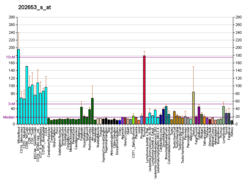| MARCHF7 |
|---|
|
| Identifiers |
|---|
| Aliases | MARCHF7, AXO, AXOT, MARCH-VII, RNF177, membrane associated ring-CH-type finger 7, MARCH7 |
|---|
| External IDs | OMIM: 613334; MGI: 1931053; HomoloGene: 10753; GeneCards: MARCHF7; OMA:MARCHF7 - orthologs |
|---|
| Gene location (Human) |
|---|
 | | Chr. | Chromosome 2 (human)[1] |
|---|
| | Band | 2q24.2 | Start | 159,712,457 bp[1] |
|---|
| End | 159,771,027 bp[1] |
|---|
|
| RNA expression pattern |
|---|
| Bgee | | Human | Mouse (ortholog) |
|---|
| Top expressed in | - Achilles tendon
- amniotic fluid
- ventricular zone
- gingival epithelium
- secondary oocyte
- oral cavity
- germinal epithelium
- ganglionic eminence
- gallbladder
- epithelium of nasopharynx
|
| | | More reference expression data |
|
|---|
| BioGPS | 
 | | More reference expression data |
|
|---|
|
| Gene ontology |
|---|
| Molecular function | - zinc ion binding
- metal ion binding
- transferase activity
- enzyme binding
- ubiquitin conjugating enzyme binding
- ubiquitin binding
- MDM2/MDM4 family protein binding
- protein binding
| | Cellular component | - nucleus
- cytosol
- plasma membrane
| | Biological process | - negative regulation of T cell proliferation
- regulation of tolerance induction
- protein ubiquitination
- positive regulation of cell population proliferation
- negative regulation of DNA damage response, signal transduction by p53 class mediator
- protein stabilization
- protein autoubiquitination
- negative regulation of proteasomal protein catabolic process
- negative regulation of intrinsic apoptotic signaling pathway in response to DNA damage by p53 class mediator
- positive regulation of protein polyubiquitination
- negative regulation of protein autoubiquitination
| | Sources:Amigo / QuickGO |
|
| Orthologs |
|---|
| Species | Human | Mouse |
|---|
| Entrez | | |
|---|
| Ensembl | | |
|---|
| UniProt | | |
|---|
| RefSeq (mRNA) | |
|---|
NM_001282805
NM_001282806
NM_001282807
NM_022826 |
| |
|---|
| RefSeq (protein) | NP_001269734
NP_001269735
NP_001269736
NP_073737
NP_001363163
|
|---|
NP_001363164
NP_001363165
NP_001363166
NP_001363167
NP_001363168
NP_001363169
NP_001363170
NP_001363171
NP_001363172
NP_001363173
NP_001363174
NP_001363175
NP_001363176
NP_001363177
NP_001363178
NP_001363179
NP_001363180
NP_001363181
NP_001363182
NP_001363183
NP_001363184 |
| |
|---|
| Location (UCSC) | Chr 2: 159.71 – 159.77 Mb | n/a |
|---|
| PubMed search | [2] | [3] |
|---|
|
| Wikidata |
| View/Edit Human | View/Edit Mouse |
|















